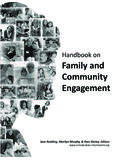Transcription of PLAY IN CHILDREN’S DEVELOPMENT, HEALTH AND WELL …
1 play IN children S development , HEALTH AND well -BEINGJEFFREY GOLDSTEINFEBRUARY 2012 Published in February 2012 Design by , BrusselsPrinted on Cocoon silk, 100% recycledABOUT THE AUTHORJ effrey Goldstein, has been at Utrecht University (Utrecht, The Netherlands) since 1992. He is currently research associate at the Research Institute for History and Culture, Utrecht University. Among his 16 books are Toys, Games and Media (with David Buckingham and Gilles Broug re. Taylor and Francis, 2004), The Handbook of Computer Game Studies (with Joost Raessens. MIT Press, 2005); Toys, play and Child development (Cambridge University Press 1994); and Why We Watch: The Attractions of Violent Entertainment (Oxford University Press, 1998). In 2011 his chapter on Technology and play appeared in A. D. Pellegrini (editor), Oxford Handbook of the development of play (Oxford University Press). Goldstein is chairman of the National Toy Council (London. ) and serves on boards of the Netherlands Institute for the Classification of Audiovisual Media ( ), and PEGI, the European video games rating board ( ).
2 He is co-founder with Brian Sutton-Smith and Jorn Steenhold of the International Toy Research Association ( ). In 2001 he received the BRIO Prize (Sweden) for research for the benefit and development of children and young people. He is on the Editorial Board of Humor: International Journal of Humor Research and the International Journal of Early Childhood Education. INTRODUCTION 31. WHY play IS IMPORTANT 5 play and the Brain play and Child development The Role of Toys 2. VARIETIES OF play 9 3. TALKING, THINKING, CREATING 11 Cognitive development Language and play play Promotes Creativity4. PLAYMATES 15 Social development Age-Mixed Playgroups / Intergenerational Play5. SEX DIFFERENCES IN play AND TOY PREFERENCES 196. play AND HEALTH 23 Obesity Active play and ADHD play and the Quality of Life 7.
3 TOO LITTLE play CAN AFFECT CHILD development 27 play Deprivation8. play AND TECHNOLOGY 299. play AND COMMUNITY 33 play and Citizenship10. TO PROMOTE play 37 Why Toys Are ImportantREFERENCES 39 TABLE OF CONTENTSPLAY DURING EARLY CHILDHOOD IS NECESSARY IF HUMANS ARE TO REACH THEIR FULL POTENTIALPlay, games and entertainment have occupied my research and writing, to say nothing of my leisure time, for the 40 years that I have been a psychologist. One happy result of my interest in these pleasurable pursuits was an invitation from Toy Industries of Europe (TIE) to prepare this review of recent research on drives my professional activities is the belief that people would not devote so much of their lives to entertaining and enjoying themselves if these did not serve some greater purpose beyond their intrinsic merits.
4 Recent developments in biology, psychology and neuroscience lend credence to the importance of play in human evolution and development . play may even be the cornerstone of society because it requires communication and cooperation among people playing different roles and following agreed-upon rules. My research has focused on how our leisure activities can be put to good use in education, business and medicine, and to improve the quality of life for children and adults (see References). Developments in science and technology have broadened our views of play . The flourishing of cognitive neuroscience (the study of the relationships between brain activity, thinking and acting) has led to new insights into the role of biology and the brain in play and toy preferences. The importance of play for mind and body has been well -documented.
5 Some research just stops you in your tracks. That is the effect that Melissa Hines and Gerianne Alexander s research had on me. They found that baby vervet monkeys display sex differences in play styles and toy preferences that mirror those of human children . So it is not only parents behaviour and marketing that produce boys and girls different toy preferences. Hormones and genes also influence children s play . It seems that males, human and nonhuman, are attracted to toys that move. People play because it is fun. One of the many ways in which play is healthy is that it results in positive emotions, and these may promote long-term HEALTH . Even if it did not do this, play improves the quality of life people feel good while playing. play has a major contribution to make in keeping an ageing population healthy. Active play has the paradoxical effect of increasing attention span and improving the efficiency of thinking and problem solving.
6 Two hours of active play per day may help reduce attention deficits and most striking thing about hi-tech toys is that the technology does not in itself drive play . Some modern toys can interact with other toys, with iPads and computers, and can recognise your voice and learn your commands. Yet much of their potential is overlooked by players. Many children play with these toys in traditional ways. In this they resemble adults who make limited use of their computer software, learning how to do what they want to do with their computers and ignoring the many features that are of less interest. In the Western world, nearly everyone believes that children benefit from free play . Research confirms that children s self-initiated play nurtures overall development , not just cognitive development (such as learning to name colours, numbers or shapes).
7 Abundant research has shown that play during early childhood is necessary if humans are to reach their full potential. Parents, teachers and government bodies all recognise the value of play . Yet opportunities for play continue to diminish, with fewer play spaces, less freedom to roam outdoors, and decreasing school time for free play . The case for play is clear, now the question is what do we do to ensure that children get the play they need and deserve? Jeffrey Goldstein Utrecht University3 INTRODUCTIONPLAY IS THE lens through which children EXPERIENCE THEIR WORLD AND THE WORLD OF OTHERSWHY play IS IMPORTANT1 play has been defined as any activity freely chosen, intrinsically motivated, and personally directed. It stands outside ordinary life, and is non-serious but at the same time absorbing the player intensely. It has no particular goal other than itself. play is not a specific behaviour, but any activity undertaken with a playful frame of mind.
8 Psychiatrist Stuart Brown writes that play is the basis of all art, games, books, sports, movies, fashion, fun, and wonder in short, the basis of what we think of as civilization. (Brown 2009). As the noted play theorist Brian Sutton-Smith remarked, the opposite of play is not work, but depression. All types of play , from fantasy to rough-and-tumble, have a crucial role in children s development . play is the lens through which children experience their world, and the world of others. If deprived of play , children will suffer both in the present and in the long-term. With supportive adults, adequate play space, and an assortment of play materials, children stand the best chance of becoming healthy, happy, productive members of AND THE BRAINA behaviour that is present in the young of so many species must have an evolutionary advantage, otherwise it would have been eliminated through natural selection.
9 What might be the advantages of play ? play increases brain development and growth, establishes new neural connections, and in a sense makes the player more intelligent. It improves the ability to perceive others emotional state and to adapt to ever-changing circumstances. play is more frequent during the periods of most rapid brain growth. Because adult brains are also capable of learning and developing new neural circuits, adults also continue to play . play theorist Brian Sutton-Smith believes that the human child is born with a huge neuronal over-capacity, which if not used will die. Not only are children developing the neurological foundations that will enable problem solving, language and creativity, they are also learning while they are playing. They are learning how to relate to others, how to calibrate their muscles and bodies and how to think in abstract terms.
10 through their play children learn how to learn. What is acquired through play is not specific information but a general mind set towards solving problems that includes both abstraction and combinatorial flexibility where children string bits of behaviour together to form novel solutions to problems requiring the restructuring of thought or A child who is not being stimulated, by being .. played with, and who has few opportunities to explore his or her surroundings, may fail to link up fully those neural connections and pathways which will be needed for later learning. (Sutton-Smith 1997). In play we can imagine situations never encountered before and learn from them. Toy aeroplanes preceded real ones. Neuroscientist Jaak Panksepp found that play stimulates production of a protein, brain-derived neurotrophic factor , in the amygdala and the prefrontal cortex, which are responsible for organising, monitoring, and planning for the future.


